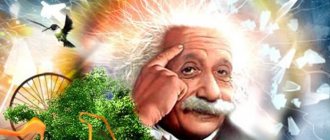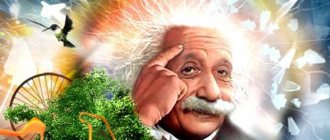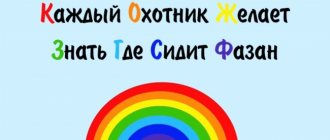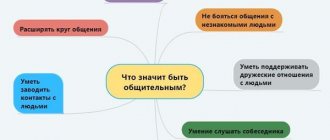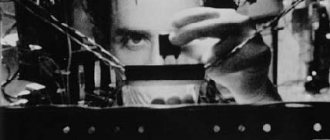What is it and how is it different from fantasy?
Imagination is a person’s ability to create images, ideas and ideas of objects based in reality in the head.
It is logical validity that distinguishes imagination from fantasy, which is a fictitious situation created by our consciousness. Fantasy does not correspond to reality, does not obey common sense, but only expresses human desires.
More than 100 cool lessons, tests and exercises for brain development
Start developing
Let me give you a simple example. Imagine a cat. Happened? Each of you got it in a different color and size. Some imagined a generalized image with four legs and ears, while others imagined a pet in the smallest detail. This is how your imagination worked. You have seen a cat in real life more than once, and therefore it was not difficult for you to recreate it in your head.
And now another experiment. If you are asked to come up with an unusual animal, you will begin to fantasize, that is, to compose. Your ideas will not be based on past experience, physical laws and other knowledge. You can compose anything, there are no restrictions. This is what is called fantasy.
Find out what role imagination plays in remembering.
Functions
- Prompting activity with the help of a bright, attractive image of its result, means and methods of implementation, generalized ideas and specific plans.
- Regulation of behavior in an uncertain, problematic situation with the help of images of alternative actions and their consequences.
- Emotional self-regulation, autopsychotherapy, illusory satisfaction of needs. This function comes with the risk of escaping reality. Replacing reality with gaming images is one of the consequences of gambling addiction.
- Organization of cognition - reconstruction of an object according to description, completion of missing elements, modeling.
What is imagination for?
Many people believe that imagination is necessary primarily for creative people: artists, composers, poets. But this is far from true. Imagination is the foundation of creative thinking. Without it, it would be impossible to dream, make plans, set goals, or enjoy beauty. Imagination is what distinguishes us all from the animal world.
Here are a number of other advantages that speak in favor of this ability:
- Expands the boundaries of what is possible. If you set goals only on the basis of already acquired experience, you will not be able to reach new heights and boundaries.
- Gives the world inventions. People dreamed of flying like birds and came up with an airplane. They fantasized that they would one day be able to talk with loved ones who were far away, and they created the telephone. All the things around us that seem familiar were once created by someone’s imagination.
- Helps solve problems in innovative ways. Instead of doing things as usual, we can use creativity and find a new and unusual way out of the situation. Sometimes he turns out to be brilliant and makes life much easier.
- Leads to discoveries. For example, Albert Einstein dreamed of a place where it would be possible to stop time and capture the best moments of his life. His thoughts led to the creation of the general theory of relativity, without which humanity would still consider time to be a constant.
- Allows you to create. It was imagination that contributed to the creation of the Marvel universe, famous musical compositions, majestic skyscrapers, designer clothes, etc. Without someone's imagination, there would not even be fairy tales and games in our childhood.
- Gives you the opportunity to admire the beauty of the world. Ever heard the phrase “Blows the mind”? This is what they say about the deep starry sky, endless mountain landscapes, and the rippling surface of the sea. A person who is not endowed with creative imagination will not spend a long time watching a fire burn or a waterfall flow, because from a practical point of view it is meaningless.
Scientists say that imagination helps create new neural connections in the brain. Due to this, a person is able to influence not only his own habits and actions, but also create the desired reality around himself. Read more about this feature of imagination in the article about what visualization is.
The evolution of one dream of humanity
Imagination is more important than knowledge, because knowledge is limited, but imagination embraces everything in the world, stimulates progress and is the source of its evolution.
Albert Einstein
The idea of flying in the air originated among people many thousands of years ago. Even the ancient Egyptians found drawings and sculptures of people with wings. The same images would later appear among the Greeks and Romans. Tales of the peoples of the world reflect this same desire. For example, the flying carpet is present in Russian and Middle Eastern fairy tales.
This dream remained a utopia until Leonardo Da Vinci, who stood out even among the geniuses of the Renaissance. There is no such person who has not heard of the Mona Lisa. We perceive Leonardo first and foremost as the greatest artist. But the “universal man” himself considered himself primarily a scientist and engineer.
He was interested in mechanics, mathematics, architecture, and the environment. In the 15th century, Leonardo Da Vinci described the valve of the right ventricle of the heart, discovered that the age of a tree is determined by the annual rings, created a camera obscura, and constructed canals and dams. His inventions are considered to be: a prototype of a tank, a diving suit or spacesuit, a self-propelled cart (a prototype of a car). Many other engineering ideas are captured in the master’s drawings, drawings and sketches. His aircraft are of greatest interest.
Leonardo, inspired by the flight of birds, dreamed of aeronautics. His drawings and sketches show for the first time how a flying machine can be built. Leonardo Da Vinci worked on different types of aircraft. He created the first ornithopter, propeller, and parachute. The brilliant inventor, who with the power of imagination looked many centuries into the future, did not realize his ideas due to the weak technologies of that time. Leonardo Da Vinci's dream of aeronautics was realized five centuries later by Igor Sikorsky.
How it happens
There are several classifications. I will give the most common ones.
According to the degree of purposefulness, the following types of imagination are distinguished: active and passive.
Active stimulates a person to create, allows him to create something new in professional and creative activities. It is divided into:
- Reproductive. It is a recreation of real images based on lived experience.
- Productive (or creative). Images are created according to their own design, almost without recourse to experience.
Passive does not have the goal of realizing invented ideas. It comes in two forms:
- Involuntary. It is an unintentional imagination that can be difficult or impossible to control. This includes random thoughts, dreams, hallucinations.
- Arbitrary. It is controllable and is associated primarily with unlikely or incredible predictions for the future. These are our dreams and dreams.
Mister Helicopter
An important role in the life of the future aircraft designer was played by his mother, who devoted her life to raising five children. She was most interested in the art and inventions of Leonardo Da Vinci. The mother's hobbies fell on fertile soil. The sound child loved to listen to his mother's stories about the infinity of the Universe and mysterious stars. But most of all, his childhood imagination was struck by stories about Leonardo Da Vinci and his idea to create an “iron bird” - a flying machine that rose into the air with the help of a powerful propeller.
His mother instilled in the future great aircraft designer a love of music and literature. Little Igor's reference book was Jules Verne's novel “Robourg the Conqueror,” which describes an aircraft that vaguely resembles a helicopter. One day, after reading this novel, the boy dreamed that he was on board a flying ship, from the windows of which one could see the sea and an island with palm trees. This dream will come true 30 years later - he will see all this on board the amphibious aircraft he designed.
After graduating from high school, Igor’s parents assigned Igor to the Naval Cadet Corps in St. Petersburg, where their eldest son was already studying. It was a privileged educational institution, but Igor was not attracted to a military career, even one related to the sea. He kept track of all the technical innovations and designed something in educational workshops during his off-hours. The desire to build airplanes and fly them finally matured after newspaper reports appeared about the first flights of the Americans - the Wright brothers.
Igor Sikorsky leaves school and devotes his future life to realizing his dream (you can read more here).
Sikorsky created about 15 types of aircraft. After his inventions, multi-engine aviation began to develop. Since 1939, he switched to designing helicopters. In 1967, Sikorsky helicopters made the world's first flight across the Atlantic Ocean, and in 1970, across the Pacific Ocean, albeit with in-flight refueling. His inventions marked the beginning of a new era, and the designer was given the nickname “Mr. Helicopter.”
Techniques for developing imagination in adults
Everyone has an imagination. It’s just that for some it is well developed, while for others, due to a logical mindset, it is relegated to the background and needs to be “stirred up”.
Let's consider what you need to do to stimulate the development of imagination:
- Replace watching TV with a suitable hobby. Serials and television shows are a type of passive recreation that does not involve mental and creative effort. But any creative activity perfectly develops the imagination and at the same time makes you happier. It is by no means necessary to be an expert in drawing, sculpting or writing poetry - create for your own pleasure. But you can read about how to develop creative abilities in our separate publication.
- Listen to music without words. Ready-made song lyrics inspire us with other people's thoughts. Even when we listen to songs in a language unfamiliar to us, it still limits the scope for thought. Collect a selection of a wide variety of melodies and try to choose your own words or images for them. It is better to use blues, jazz or classical music for this. But here, as they say, it’s a matter of taste. By the way, you can also try watching movies without sound, trying to understand what they are talking about.
- Read books of different genres. Fiction and fantasy are especially useful for the imagination.
- Keep a diary. You can write down any interesting thoughts there, make up stories, or simply tell how your day went. Writing greatly stimulates the imagination and flight of thoughts.
- Get new experiences. Go to exhibitions, visit museums, communicate with interesting people, replace your usual routes with new ones, study, travel.
- Don't be shy to dream. Dreams are not just the prerogative of little children. It is also useful for adults to fantasize about a bright future. This will relieve boredom and develop imagination.
Here are a few problems.
Task No. 1. Imagine in your mind a triangle, each side of which is 2 meters. Now, from the base of this triangle, mentally draw a line to the right, another 2 meters. Then draw exactly the same line to the right of the vertex parallel to the first one and connect their ends to each other. What kind of figure did you get? Just no notepads! Use only your imagination.
Task No. 2. This exercise will require a self-test. Below I will name the words, and you must imagine them in your head. You need to assign a point to each image:
- if there is no image at all – 0;
- if it is weak - 1;
- good image – 2;
- very bright and distinct – 3.
So, the words will be divided into several categories:
- Visual images – car, sparrow, cherry, supermarket.
- Auditory - a barking dog, a school bell ringing from class, rumbles of thunder.
- Tactile - cat fur, wind, ladybug crawling on the hand.
- Olfactory – strawberries, freshly cut grass, garlic, fire.
You can add any images to the categories provided.
Before performing the next exercise, I advise you to read about what associations are.
Task No. 3. You need to match association objects to different colors. For example, when you hear “purple,” what comes to mind? Perhaps it’s an eggplant, a car that color, a shade of the rainbow, etc. What about orange, gray, burgundy? Select as many objects or phenomena as possible.
Task No. 4. Droodles will help us. These are graphic puzzles, which are conventional images that need to be drawn into a meaningful object. This can be done either alone or in a group.
How the process can happen:
- Each player takes turns giving their version of what is shown in the picture. Those who do not have a version are eliminated from the game. The action continues until there is only one winner left.
- One player-leader draws a graphic template and invites the other participants to come up with a continuation. The one with the most ideas wins.
Below I have given an example of what droodles look like.
How images arise
There are various ways to create them.
Emphasis is the highlighting of any parts, features or properties. The following techniques are used here:
Typification is a generalization of an image and its emotional saturation. Many literary heroes are shining examples of typification. For example, Gogol’s landowners from “Dead Souls”: Manilov is a barren dreamer, Korobochka is a greedy hoarder, Nozdryov is a dashing reveler.
Combination is the creation of a new one by combining parts of an existing one.
Exaggeration is the deliberate strengthening of any characteristic feature or phenomenon. For example, the expression: “This morning I drank ten liters of coffee” would be an exaggeration.
Exaggeration and understatement. Gulliver can be considered a striking example of both.
Combination is a combination of elements that already exist in new combinations.
Methods and exercises for children
Children primarily copy the behavior of adults. Therefore, if you want to develop imagination and fantasy in your child, then cultivate these abilities in yourself. Here are some recommendations:
- Read books with a fantastic plot with your child, and then discuss the details, ask what the characters might look like if the child himself drew them. Teenagers can be invited to read the works of Jules Verne and the Strugatsky brothers.
- Ask unusual questions. For example, ask what supernatural ability the child would like to be endowed with or what animal, in his opinion, is missing in nature. What will happen if electricity disappears forever or people live underwater and fish live on land?
- Ask how a child's life would change if he suddenly became the size of a pencil or, conversely, became as big as a giant. Let him fantasize and tell him how his normal day might go.
- Invite your child to imagine himself as a plant, a stone, a bird, a dinosaur, a shark, an insect, etc. Ask questions about how he feels, what desires he has, what or who he is afraid of, etc.
- Turn on a cartoon that the child has not yet watched and ask him to voice it at random. By the way, you can take on the roles of different heroes and train together.
From the weakest to the top of the hierarchy
It was not without reason that our distant ancestor had the imagination many thousands of years ago. Without it, he could not survive in the primitive savannah.
Primitive people, having neither fangs nor claws, not possessing the speed of a cheetah or the strength of a lion, found it very difficult to compete with animals for a place in the sun: to get their own food and not become it themselves.
75,000 years ago, our ancestor was the weakest on the savannah, on the verge of extinction from starvation. The human population was about 2000 individuals, the descendants of which are modern humanity. In science, this period is usually called the “bottleneck effect.”
Besides us, Homo Sapiens, there were seven other currently known species of humans. After a short time by historical standards, our species destroyed all other species of people, exterminated most animal species on the planet and took first place in the food hierarchy. How did we manage to do this?
Useful materials on the topic
In conclusion, here is a small selection of literature for those who want to delve deeper into the topic of imagination:
- Michael Mikalko “Rice Storm and 21 More Ways to Think Outside the Box”
- Michael Mikalko “Hacking creativity. How to see what others don’t see”
- Dan Roem "Visual Thinking"
- Asoskova Y., Kinyakina O., Zakharova T. “Brain 100%. Intelligence. Memory. Creative. Intuition"
- Christoph Niemann “Sketch on Sundays”
- Estanislao Bachrach “Flexible Mind”
- Mark Levy “Genius to order”
- Edward de Bono "Six Thinking Hats"
- Austin Kleon Steal Like an Artist. 10 Lessons on Creative Self-Expression”
- Marina Moskvina “Learn to see. Lessons from creative upswings”
- Jonah Lehrer “Imagine. How creativity works"
I also recommend the Course on the development of creative thinking from the Vikium platform. It will help not only develop imagination and attention, but also learn how to create and implement your ideas, and find non-standard solutions. The program consists of 16 lessons with videos, graphic diagrams and assignments. The cost of participation is 1,490 rubles.
Bottom line
If you enter “How to develop imagination and fantasy” into the search engine, you can find all sorts of games that develop imagination and various exercises. But I believe that the imagination should work constantly, and not just 5 minutes a day. Therefore, the tips I have chosen are suitable for everyday use and will allow you to use your imagination as often as possible.
There is also an interesting topic - how to develop fantasy and imagination in a child. I will write about this in another article. Subscribe so you don't miss a publication.
Friends, write in the comments your ways to develop imagination and fantasy. Perhaps I will supplement the article with new options.
And write which dog you presented :)
Until we meet again, yours, Alexander Gorokhov.
A Look at the Root
Yet imagination is also a tool that creates a better future. “To imagine the future is to change it,” writes urban futurist Darran Anderson. Many of his colleagues talk about the radical imagination—as left-wing political strategist Patrick Rainsborough defines it as the kind of imagination that gets to the roots of systemic problems (radical also means “root”).
An example of radical imagination is science fiction literature. Sci-fi is often treated with disdain, but the best examples of the genre carry a truly powerful utopian charge. To describe it, researcher Darko Suvin introduced the concept of novum - this is a law, a technical invention or a changed state of nature, which forces us to reconsider all the principles by which life flows.
Suvin called science fiction the literature of cognitive defamiliarization.
Unlike free imagination, which does not always develop linearly and logically, sci-fi requires authors to consistently develop a new world at a variety of levels - from material infrastructures to social structure.
The value of long literary texts lies in the detail that theories rarely achieve.
But, in addition, science fiction writers always start from the current moment - they defamiliarize (describe from the outside) reality, and therefore criticize it. Here are some famous examples of science fiction literature becoming part of, if not the basis of, liberation movements.
American science fiction writer Ursula Le Guin
became famous for her feminist utopias. For example, in the novel “The Left Hand of Darkness” peopled the world with people with consistent hermaphroditism: the gender of the heroes and heroines changed cyclically along with the position of the planet, and most of the time was completely absent. In 1969, the career and family opportunities that such a novel would open up for everyone seemed almost unthinkable—even though feminist fiction, while much less well-known, had already been decades old by that point.
Afrofuturist Octavia Butler
made black people the main characters of her novels, while white science fiction writers usually simply forgot about their existence. One of the leitmotifs of it, and indeed of all Afrofuturism, was the imagination of the golden age of Africa: both in the past, before colonization, and in the future, when racism has been overcome.
In China, the rise of sci-fi began at the turn of the 2000s and 2010s. The government began to support fantastic literature, believing that with its help it would train the imagination of citizens and they would be able not only to produce, but also to develop innovative technologies. Meanwhile, the authors (most famously Han Song
,
Chen Qiufang
and
Liu Cixin
) disguise social criticism as science fiction: they write about the general surveillance society that already exists in China, emphasize how secretive and opaque the power structures are, and sometimes use very specific images - for example, they describe a “huge field trash" near Guangdan, where Chen Qiufang grew up and where migrant workers now "use their own hands to disassemble pieces of electronic devices, melting metal in fire or dissolving parts in acid."
In general, science fiction writers rely on real problems when they imagine a utopian (or more often dystopian) future. Futurologists do the same, who engage in forecasting no longer for the sake of art, but advise large businesses and political campaigns.
Sociologist John Urry wrote a book in 2016, “What the Future Looks Like,” in which he identified six techniques by which humanity prepares for tomorrow:
1. They draw analogies with the past - for example, when they now predict how new technologies will affect society, they remember how the world has changed after the advent of telephone communications or computers. These versions are often fairly accurate in content, but not in timing, because they rarely account for game-changing surprises (like the silicon processors that made computers explode in power in the 1960s).
2. They study which futures did not materialize and why - for example, it became clear that forecasts in which new technologies instantly replace old ones rarely make sense. More often they coexist for a long time - it’s both a matter of social habits and economic benefits.
3. Express their fears in dystopias. Urry identifies five common dystopian stories:
- collapse of society due to resource depletion; — installation of total control; - atomization, in which human communication becomes impossible due to psychological changes or external conditions; - the emergence of many rules and laws that lead to loss of wealth; - seizure of power by cyborgs.
4. They create utopias.
5. Extrapolate elements of the present - describe how a certain trend that has already formed in the present will determine the future.
6. Scenario planning (retropolation) is the most interesting option: first they describe the world after a given amount of time, and then analyze what events and at what moment will have to happen in order to get to the described state from the current one. An example of retropolation is the book “The World We Made” by Jonathon Porritt, one of the leaders of the green movement. In it, the narrator speaks from 2050, but all the time he remembers what events allowed humanity to switch almost entirely to renewable resources and significantly reduce economic inequality.
True, this book also illustrates that the political imagination rarely manages to capture all the important issues: Porritt does not write about how to cope with gender or racial inequality.
From bills to hi-tech
The industrial revolution of the 19th century and the information revolutions of the 20th century succeed each other. Everything goes towards increasing, complicating and accelerating. The importance of developed imagination also increases.
Half a century ago, children at school were taught to count on an abacus. Modern life cannot be imagined without computers and high-speed Internet - an additional reality that creates an absolute connection between people.
Humanity is on the verge of a new technological breakthrough - robots and artificial intelligence. Before we even had time to think about what this threatens us with, some even got scared, when a new scourge - the coronavirus. Nature forces humanity to unite, otherwise the epidemic cannot be dealt with. Only united humanity will be able to move into a new phase of development - the urethral one.
As strange as it may sound, a developed imagination can help us survive the pandemic.
